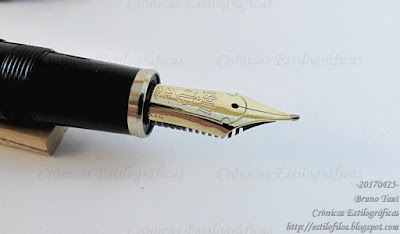Romeo and Mighty were two popular brands for those pens, and Romeo, in fact, is still used nowadays. Some other pens were simply labeled as Itoya, or “The Itoya Pen”, as we are about to see. Finally, Itoya currently markets high end pens under the brand Taccia, and some inexpensive, Taiwan made, pens as Natsuki.
The pen on display today is an Itoya pen made of celluloid. Instead of being cylindrical, its body and cap are octagonal. The filling mechanism is a sac operated by a lever. A similar pen, albeit made of black hard rubber (ebonite) and signed as Romeo, can be seen on the book Fountain Pens of Japan, by Lambrou and Sunami (ISBN: 978-0-9571230-0-2) on page 120.

The barrel is obviously engraved: "THE ITOYA PEN". No other brand name appears on the pen. Cap ring and clip are labeled with the gold content: "R14K", rolled gold, 14 K.
These are the dimensions of the celluloid version:
Length closed: 118 mm
Length open: 107 mm
Length posted: 154
Diameter (cap crown): 16 mm
Weight: 15.7 g (dry)
This pen sports a beautiful nib of size 3 made of 14 K gold. The pen was manufactured, probably, during the first half of the 1930s.
My thanks to Mr. Sugimoto.
Sailor Pro Gear – Sailor Black
Bruno Taut
Nakano, May 19th 2017
etiquetas: Itoya
Bruno Taut
Nakano, May 19th 2017
etiquetas: Itoya





























